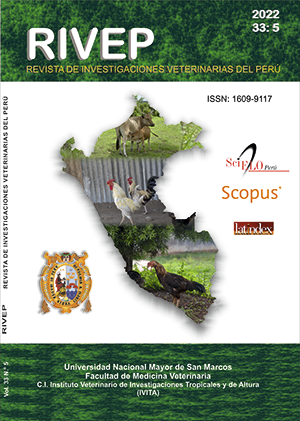Evaluation of inbreeding and genetic variability of the Peruvian Paso Horse registered in Ecuador
DOI:
https://doi.org/10.15381/rivep.v33i5.21672Keywords:
gait, ancestor, demography, increase in consanguinity, kinship, pedigreeAbstract
The Peruvian Paso Horse (CPP) is a breed with a four-stroke gait originating in Peru from the horses that arrived at the time of the conquest of America. The aim of this study was to know the level of inbreeding and the effect on genetic variability in the breed. In total, 8330 animals were analysed that included the population of CPP born in Ecuador and their Peruvian ancestry (PT) and two reference populations of animals born in Ecuador (PE) and born between 2008 and 2018 (PR). The average traced generations were 9.18 ± 3.89 (PT), 11.14 ± 2.23 (PE) and 12.83 ± 1.42 (PR) and the completeness of the pedigree was over 90% in the first, fourth and fifth generations of PT, PE and PR, respectively. Average generation interval of 8.72 ± 4.56 (PT), 8.79 ± 4.30 (PE) and 9.20 ± 4.61 (PR). Average individual consanguinity: 5.97% (PT), 6.83% (PE) and 8.11% (PR) and kinship relationship: 9.02% (PT), 10.56% (PE) and 11.56% (PR). Individual increase in consanguinity per year was 0.13% and per generation 1.13%. The effective size of the population was less than 50. The probabilities of origin of the genes were greater than one. The occurrence of loss of genetic variability due to the bottleneck effect and genetic drift is concluded.
Downloads
Downloads
Published
Issue
Section
License
Copyright (c) 2022 Carlos Octavio Larrea Izurieta, Mayra Gómez Carpio, Vinzenzo Landi, Ernesto Antonio Hurtado, Jorge Ignacio Macías Andrade, Leila Estefanía Vera Loor, Edwin Lozada Rivadeneira, Luis Favian Cartuche Macas

This work is licensed under a Creative Commons Attribution 4.0 International License.
AUTHORS RETAIN THEIR RIGHTS:
a. Authors retain their trade mark rights and patent, and also on any process or procedure described in the article.
b. Authors retain their right to share, copy, distribute, perform and publicly communicate their article (eg, to place their article in an institutional repository or publish it in a book), with an acknowledgment of its initial publication in the Revista de Investigaciones Veterinarias del Perú (RIVEP).
c. Authors retain theirs right to make a subsequent publication of their work, to use the article or any part thereof (eg a compilation of his papers, lecture notes, thesis, or a book), always indicating the source of publication (the originator of the work, journal, volume, number and date).










